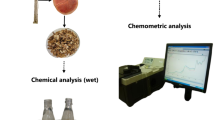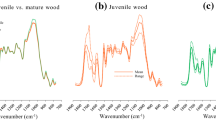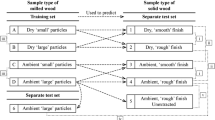Abstract
The use of furfuryl alcohol (FA) as a wood modification agent has been known for decades. An independent and reliable analytical method to determine the level of furfurylation is not available. This article reports the use of near infrared spectroscopy (NIR) and thermogravimetric analysis (TGA) to make partial least square prediction models for determining the furfurylation level (the percentage of FA polymer formed within the wood structure). A total of 115 individual samples of furfurylated Scots pine (Pinus sylvestris) originating from 115 production batches were used for modelling. As much as 81 samples were randomly selected for the calibration set and 34 samples for the validation set. Both NIR and TGA gave good predictions when validated by a separate test set. The r 2 for NIR and TGA are 0.93 and 0.94, respectively, and the root mean square errors of predictions are 1.025 and 0.958, respectively. However, the number of principal components for the NIR and TGA models is two and six, respectively. The NIR method is preferred because only two principal components are used and sampling is fast.





Similar content being viewed by others
References
Anaya M (1987) Impregnation procedure based on furfuryl alcohol monomer into wood and other materials. Cuban patent CU21453
Anaya M, Alvarez A, Novoa J, González M, Mora M (1984) Modification of wood with furfuryl alcohol. Rev Sobre Derivados Cana Azucar 18:49–53
Anon (2005) Introduction to NIR. Technology Analytical Spectral Devices Inc ASD document 600510 Rev C, Vienna
Bamber RK, Burley J (1983) The wood properties of Radiata pine. Commonwealth Agricultural Bureau, Slough
Dunlop AP, Peters FN (1953) The furans. Reinhold Publishing Corp, New York
Eikenes M, Flæte PO, Haartveit EY, Lande S (2004) Prediction of weight percent gain (WPG) of furfurylated wood by FT-NIR spectroscopy. International Research Group on Wood Protection, Ljubljana. IRG/WP doc no 04-20295, 6–10 June
Epmeier H, Westin M, Rapp A (2004) Modified wood: comparison of some selected properties. Scand J For Res 19(Suppl 5):31–37
Goldstein IS (1955) The impregnation of wood to impart resistance to alkali and acid. For Prod J 5:265–267
Goldstein IS (1960) Impregnating solutions and methods. Patent GB846680
Goldstein IS, Dreher WA (1960) Stable furfuryl alcohol impregnating solutions. Ind Eng Chem 52:57–58
González R, Martínez R, Ortiz P (1992) Polymerization of furfuryl alcohol with trifluoroacetic acid: the influence of experimental conditions. Makromol Chem 193(1):1–9
Grønli MG, Varhegyi G, Di Blasi C (2002) Thermogravimetric analysis and devolatilization kinetics of wood. Ind Eng Chem Res 41:4201–4208
Lande S, Eikenes M, Westin M (2004a) Chemistry and ecotoxicology of furfurylated wood. Scand J For Res 19 (Suppl 5):14–21
Lande S, Westin M, Schneider MH (2004b) Properties of furfurylated wood. Scand J For Res 19 (Suppl 5):22–30
Martens H, Næs T (1989) Multivariate calibration. Wiley, Chichester
Næs T, Isaksson T, Fearn T, Davies TA (2002) User-friendly guide to multivariate calibration and classification. NIR Publications, Chichester
Nordstierna L, Lande S, Westin M, Furó I, Brynildsen P (2007) 1H NMR demonstration of chemical bonds between lignin-like model molecules and poly(furfuryl alcohol): relevance to wood furfurylation. Third European conference of wood modification October 15–16, Cardiff
Osborne BG, Fearn T, Hindle PH (1993) Practical NIR spectroscopy with applications in food and beverage analysis, 2nd edn. Longman Scientific and Technical, Essex
Pasquini C (2003) Near infrared spectroscopy: fundamentals practical aspects and analytical applications. J Braz Chem Soc 14(2):198–219
Schneider MH (1995) New cell wall and cell lumen wood polymer composites. J Wood Sci Technol 29:135–158
Schneider MH (2006) Furan polymer impregnated wood. US Patent 7008984
Stamm AJ (1977) Dimensional stabilization of wood with furfuryl alcohol. In: Goldstein I (ed) Wood technology: chemical aspects, ACS symposium series 43. American Chemical Society, Washington DC, pp 141–149
van Riel S, Lande S, Larnøy E, Eikenes M (2007) Quality control of furfurylated Scots pine by TGA. Third European conference of wood modification October 15–16, Cardiff
Westin M (1995) Utveckling och utvärdering av nya alternativa träskyddsbehandlingar (Development and evaluation of new alternative wood preservation treatments) Mid-term status report to The Swedish Council for Forestry and Agricultural Research (SJFR), Copenhagen, 25 p
Westin M, Ohlsson B, Simonson R, Nilsson T (1996) New chemicals for wood preservation and new ways of chemical modification. In: Proceedings of the 212th ACS national meeting, Orlando
Acknowledgments
We acknowledge the investigation and extensive testing of analytical methods for WPG prediction of furfurylated wood by The Norwegian Forest and Landscape Institute. Special thanks are given to Morten Eikenes, Per Otto Flæte, Monica Fongen, Eva Grodås and Sigrun Kolstad for their assistance, and to the Norwegian Research Council for funding this and previous work. We also thank Arne Henriksen at Hydro Research Centre for his kind contribution to the NIR analysis with fruitful discussions and access to the NIR instrument.
Author information
Authors and Affiliations
Corresponding author
Rights and permissions
About this article
Cite this article
Lande, S., van Riel, S., Høibø, O.A. et al. Development of chemometric models based on near infrared spectroscopy and thermogravimetric analysis for predicting the treatment level of furfurylated Scots pine. Wood Sci Technol 44, 189–203 (2010). https://doi.org/10.1007/s00226-009-0278-x
Received:
Published:
Issue Date:
DOI: https://doi.org/10.1007/s00226-009-0278-x




